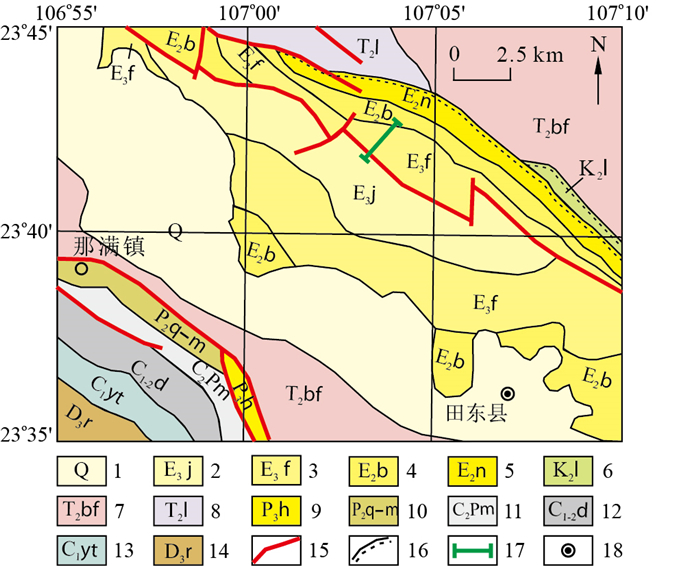Paleovegetation and paleoclimate in the Baise Basin during Oligocene
-
摘要:
为恢复百色盆地渐新世古植被面貌并重建古气候, 对该盆地伏平组孢粉化石进行了采样、分析、鉴定, 共获得孢粉化石34属, 并划分为2个组合: (Ⅰ)
Abietineaepollenites-Quercoidites-Polypodiaceaesporites 组合; (Ⅱ)Abietineaepollenites-Pinuspollenites-Pediastrum 组合。组合Ⅰ时代为渐新世Rupelian中期; 组合Ⅱ时代为渐新世Rupelian晚期至Chattian早期。植被面貌变化为: 针阔混交林, 底部生长着蕨类植被→针叶林。通过孢粉组合属性特征的研究得出孢粉组合Ⅰ代表了亚热带湿润性气候, 湿度相对较大; 孢粉组合Ⅱ代表了亚热带较湿润性气候。通过共存因子分析得出: 在渐新世Rupelian中期至Chattian早期时间段内百色盆地年均降雨量(MAP)在797.5~1 293.7 mm之间, 年均温度(MAT)在11.3~22.6℃之间, 为北亚热带气候特征。而现在的百色盆地位于南亚热带(年均温度: 22.0℃, 年均降雨量: 1 070.5 mm), 二者的差异可能与新生代印度板块与亚洲板块碰撞所造成的亚洲板块"右旋"有关。Abstract:To reconstruct the palaeovegetation and palaeoclimate in the Baise Basin during the Oligocene, in this work, we analyzed sporopollen fossils from the Fuping Formation in this region. Thirty-four genera sporopollen fossils are found and divided into two assemblages: (Ⅰ)
Abietineaepollenites-Quercoidites-Polypodiaceaesporites Assemblage and (Ⅱ)Abietineaepollenites-Pinuspollenites-Pediastrum Assemblage. The age of assemblage Ⅰ and Ⅱ are mid-Rupelian to Oligocene, and late-Rupelian to early-Chattian to Oligocene, respectively. The paleovegetation changed from conifer-broad leaf forest with fern vegetation growing at the bottom to coniferous forest. Through the study of the characteristics of the palynological assemblages, assemblage Ⅰ represents a subtropical humid climate condition with relatively high humidity, while assemblage Ⅱ represents a humid climate condition in the subtropical zone. The coexistence approach of the nearest living relatives of the palynomorphs shows that during the period of the mid-Rupelian to the early Chattian of the Oligocene, the mean annual precipitation (MAP) was 797.5-1 293.7 mm, and the mean annual temperature (MAT) was 11.3-22.6℃ in the Baise Basin. The characteristics of this basin were a northern subtropical climate during the mid-Rupelian to the early Chattian. However, the present Baise Basin is located in the southern subtropics(MAT: 22.0℃, MAP: 1 070.5 mm). The difference between the Oligocene and today may be related to the "right-rotation" of the Asian Plate caused by the collision between the Cenozoic Indian Plate and the Asian Plate.-
Key words:
- Baise basin /
- Oligocene /
- sporopollen assemblage /
- paleoclimate /
- coexistence approach
-
图 3 百色盆地田东剖面渐新统伏平组部分典型孢粉
Figure 3. Major representatives of spores and pollens from the Oligocene Fuping Formation at the Tiandong section in the Baise Basin
1, 2.Polypodiaceaesporites; 3, 5.Tsugaepollenites; 4.Abietineaepollenites; 6.Pterisisporites; 7, 8.Betulaceoipollenites; 9. Quercoidites; 10.Pinuspollenites; 11.Cicatricosisporites; 12.Lonicerapollis; 13.Piceapollis; 14.Tricolpites; 15.Juglanspollenites; 16.Retitricolpites; 17.Polypodiisporites; 18.Ulmipollenites; 19.Graminidites
图 4 百色盆地各气候期古植被面貌变迁示意图
Figure 4. Paleovegetation evolution of each climate stage during the Oligocene in the Baise Basin
1.Abietineaepollenites; 2.Pinuspollenites; 3.Piceapollis; 4.Abiespollenites; 5.Dacrydiumites; 6.Podocarpidites; 7.Tsugaepollenites; 8.Quercoidites; 9.Ulmipollenites; 10.Juglanspollenites; 11.Caryapollenites; 12.Alnipollenites; 13.Ostryoipollenites; 14.Herbs; 15.Ferns; 16.Pediastrum
图 6 渐新世深海温度变化曲线[1]与百色盆地气候期对比图(注:该曲线与全球温度变化趋势大体一致)
Figure 6. Comparison of deep sea temperature curves with climate stages in the Baise Basin during the Oligocene
图 7 印度板块与亚洲板块碰撞前后古纬度图(据文献[26]修改)
Figure 7. Paleolatitude maps before and after the collision of the Indian plate and the Asian plate
表 1 百色盆地伏平组孢粉及生态习性统计
Table 1. Ecological habits of the spores and pollens from the Fuping Formation in the Baise Basin
孢粉类型 科 属 组合Ⅰ/% 组合Ⅱ/% 气候带类型 干湿度类型 NG-1 NG-3 NG-5 NG-6 裸子植物 松科 Pinuspollenites 2.4 7.2 5.1 14.8 温带-亚热带 中生 Abietineaepollenites 20.6 22.6 62.2 64.3 温带-亚热带 中生 Piceapollis 0.8 1.0 3.2 5.1 温带 湿润 Abiespollenites 1.4 温带 湿润 Tsugaepollenites 4.0 3.6 3.2 2.3 热带-亚热带 湿润 罗汉松科 Podocarpidites 2.4 3.1 0.5 1.3 热带-亚热带 湿润 Dacrydiumites 0.8 1.0 0.3 温带-亚热带 湿润 杉科 Taxodiaceaepollenites 0.5 温带-亚热带 湿润 被子植物(木本) 桦科 Betulaceoipollenites 0.5 亚热带-温带 湿润 Carpinipites 0.9 温带 中生 Ostryoipollenites 1.6 3.1 0.5 温带 中生 Alnipollenites 1.6 2.1 温带-亚热带 湿润 胡桃科 Juglanspollenites 2.4 1.0 2.3 0.6 亚热带-温带 中生 Caryapollenites 2.4 2.1 0.5 1.6 热带-亚热带 中生 Engelhardtioidites 0.5 0.3 热带-亚热带 中生 榆科 Ulmipollenites 0.8 0.5 1.4 0.6 温带-亚热带 中生 槭树科 Aceripollenites 0.3 温带-亚热带 中生 壳斗科 Quercoidites 10.3 6.2 5.5 1.0 温带-亚热带 中生 漆树科 Rhoipites 0.8 1.5 热带-亚热带 中生 蕈树科 Liquidambarpollenites 4.1 0.5 0.6 热带-亚热带 中生 忍冬科 Lonicerapollis 0.3 温带-亚热带 中生 被子植物(草本) 禾本科 Graminidites 0.5 热带-亚热带 旱生 唇形科 Labitricolpites 1.4 广温 中生 百合科 Liliacidites 0.3 广温 中生 科未定 Tricolpopollenites 0.8 0.5 0.5 1.6 亚热带 中生 Retitricolpites 0.8 0.5 4.1 0.6 广温 中生 Tricolpites 1.4 1.3 热带-亚热带 中生 蕨类植物 凤尾蕨科 Pterisisporites 7.9 7.7 1.4 0.6 热带-亚热带 湿润 水龙骨科 Polypodiisporites 9.5 9.2 0.9 0.6 热带-亚热带 湿润 Polypodiaceaesporites 16.7 7.7 0.9 热带-亚热带 湿润 Monolites 11.9 12.8 0.5 0.3 热带-亚热带 湿润 Polypodiaceoisporites 2.6 热带-亚热带 湿润 海金砂科 Lygodiumsporites 0.8 热带-亚热带 湿润 Cicatricosisporites 0.3 热带-亚热带 湿润 科未定 Deltoidospora 0.8 0.6 热带-亚热带 湿润 藻类 水网藻科 Pediastrum 708(粒) 142(粒) 表 2 百色盆地伏平组孢粉植物群和其现存最近亲缘类群以及其参数
Table 2. Palynofloras from the Fuping Formation in the Baise Basin and their nearest living relatives and their climatic amplitudes
孢粉类型 现存最近亲缘类群 年均温度/℃ 年均降雨量/mm 最小值 最大值 最小值 最大值 裸子植物 Pinuspollenites Pinus[17] -5.2 24.7 170.5 2 822.7 Abietineaepollenites Abies[18] 2.8 23.0 170.5 1 785.2 Piceapollis Picea[17] -4.9 22.7 291.6 1 815.6 Tsugaepollenites Tsuga[19] -0.4 23.8 279.4 2 394.5 Podocarpidites Podocarpus[17] 8.5 24.7 797.5 1 653.5 Taxodiaceaepollenites Taxodiaceae[19] 5.7 24.7 459.5 2 447.1 被子植物 Betulaceoipollenites Betula[19] -4.9 23.2 291.6 1 815.6 Carpinipites Carpinus[18] 2.3 25.5 570.3 1 785.2 Ostryoipollenites Betulaceae[18] -4.9 23.2 291.6 1 815.6 Alnipollenites Alnus[19] -5.2 23.8 355.2 2 394.5 Juglanspollenites Juglans[19] -1.6 23.0 257.5 2 074.4 Caryapollenites Carya[19] 11.3 22.6 601.1 1 942.5 Engelhardtioidites Juglandaceae[19] -1.6 24.7 257.5 1 653.5 Ulmipollenites Ulmus[19] -5.2 25.5 16.4 1 900.3 Aceripollenites Acer[19] -1.1 24.0 115.0 2 559.0 Quercoidites Quercus[19] -5.2 25.5 209.1 1 900.3 Rhoipites Rhus[19] -0.4 23.8 277.6 2 394.4 Liquidambarpollenites Liquidambar[20] 8.5 23.2 474.6 1 942.5 Lonicerapollis Caprifoliaceae[18] -4.1 25.5 303.9 1 869.9 Graminidites Gramineae[18] -4.9 25.5 303.9 2 447.1 Labitricolpites Labiatae[18] -4.9 24.7 16.4 1 942.5 Tricolpites Hamamelidaceae[18] 8.5 25.5 531.0 1 293.7 -
[1] Zachos J C, Pagani M, Sloan L, et al. Trends, rhythms, and aberrations in global climate 65 Ma to present[J]. Science, 2001, 292: 686-693. doi: 10.1126/science.1059412 [2] 王晓梅, 王明镇, 张锡麒. 中国晚始新世-早渐新世地层孢粉组合及其古气候特征[J]. 地球科学: 中国地质大学学报, 2005, 30(3): 309-316. doi: 10.3321/j.issn:1000-2383.2005.03.006Wang X M, Wang M Z, Zhang X Q. Palynology assemblages and paleoclimatic character of the Late Eocene to the Early Oligocene in China[J]. Earth Science: Journal of China University of Geosciences, 2005, 30(3): 309-316(in Chinese with English abstract). doi: 10.3321/j.issn:1000-2383.2005.03.006 [3] 苗运法, 方小敏, 宋之琛, 等. 青藏高原北部始新世孢粉记录与古环境变化[J]. 中国科学: 地球科学, 2008, 38(2): 187-196. https://www.cnki.com.cn/Article/CJFDTOTAL-JDXK200802005.htmMiao Y F, Fang X M, Song Z C, et al. Eocene sporopollen records and ancient climate change of northern Tibetan Plateau[J]. Science in China: Earth Science, 2008, 38(2): 187-196 (in Chinese with English abstract). https://www.cnki.com.cn/Article/CJFDTOTAL-JDXK200802005.htm [4] Mosbrugger V, Utescher T. The coexistence approach: A method for quantitative reconstruction of Tertiary terrestrial paleoclimate data using plant fossils[J]. Palaeogeography, Palaeoclimatology, Palaeoecology, 1997, 134: 61-86. doi: 10.1016/S0031-0182(96)00154-X [5] 徐增连. 青藏高原东北缘循化盆地渐新世-中新世孢粉记录与东亚季风演化[D]. 武汉: 中国地质大学(武汉), 2015.Xu Z L. Oligocene-Miocene pollen records in Xunhua Basin, northeastern Tibetan Plateau and its implications for evolution of the East Asian monsoon[D]. Wuhan: China University of Geoscience(Wuhan), 2015(in Chinese with English abstract). [6] 杨荣玉. 广西百色盆地第三系孢粉组合及时代[J]. 广西地质, 1994, 7(3): 1-11. https://www.cnki.com.cn/Article/CJFDTOTAL-GXDZ403.000.htmYang R Y. Association and time of Tertiaty sporo-pollen in Baise Basin, Guangxi[J]. Guangxi Geology, 1994, 7(3): 1-11(in Chinese with English abstract). https://www.cnki.com.cn/Article/CJFDTOTAL-GXDZ403.000.htm [7] 童国榜, 郑绵平, 王伟铭, 等. 广西百色盆地始新世孢粉组合与环境[J]. 地层学杂志, 2001, 25(4): 273-278. doi: 10.3969/j.issn.0253-4959.2001.04.006Tong G B, Zheng M P, Wang W M, et al. Eocene palynological assemblages and environments in the Baise Basin of Guangxi[J]. Journal of Stratigraphy, 2001, 25(4): 273-278(in Chinese with English abstract). doi: 10.3969/j.issn.0253-4959.2001.04.006 [8] 高瑞祺, 赵传奉, 乔秀云, 等. 松辽盆地白垩纪石油地层孢粉学[M]. 北京: 地质出版社, 1999.Gao R Q, Zhao C F, Qiao X Y, et al. Palynology of Cretaceous petroleum strata in Songliao Basin[M]. Beijing: Geology Press, 1999(in Chinese). [9] 宋之琛, 刘耕武. 西藏东北部老第三纪孢粉组合及其古地理意义[C]//中国科学院青藏高原地质科学考察队. 西藏古生物: 第5分册[M]. 北京: 科学出版社, 1982.Song Z C, Liu G W. Early Tertiary palynoflora and its significance of palaeogeography from northern and eastern Xizang[C]//Geological Expedition Team of Qinghai-Tibet Plateau, Chinese Academy of Sciences. Palaeontology of Xizang: Book 5. Beijing: Science Press House, 1982(in Chinese). [10] 谢金有, 李君, 麦文, 等. 北部湾盆地涠洲组和流沙港组孢粉组合及时代[J]. 古生物学报, 2012, 51(3): 385-394. https://www.cnki.com.cn/Article/CJFDTOTAL-GSWX201203012.htmXie J Y, Li J, Mai W, et al. Palynofloras and age of the Liushagang and Weizhou Formations in the Beibuwan Basin, South China Sea[J]. Acta Palaeontologica Sinica, 2012, 51(3): 385-394(in Chinese with English abstract). https://www.cnki.com.cn/Article/CJFDTOTAL-GSWX201203012.htm [11] 王伟铭, 陈耿娇, 廖卫. 广西南宁盆地渐新世孢粉植物群及其古环境意义[J]. 第四纪研究, 2015, 35(3): 650-659.Wang W M, Chen G J, Liao W. Oligocene palynoflora from Nanning Basin in Guangxi and its palaeoenvironmental significance[J]. Quaternary Sciences, 2015, 35(3): 650-659(in Chinese with English abstract). [12] 徐景先, 王宇飞, 李承森. 定量分析第三纪气候与环境的新方法: 共存类群生态因子分析法[C]//佚名. 植物科学进展: 第3卷. 北京: 高等教育出版社, 2000.Xu J X, Wang Y F, Li C S. A method for quantitative reconstruction of Tertiary palaeoclimate and environment: The coexistence approach[C]//Anon. Advances in plant sciences: Vol. 3. Beijing: Higher Education Press, 2000(in Chinese). [13] 寇香玉. 新生代孢粉分析与古气候定量重建的研究[D]. 北京: 中国科学院植物研究所, 2005.Kou X Y. Studies on quantitative reconstruction of Cenozoic climates in China by palynological data[D]. Beijing: Institute of Botany, Chinese Academy of Sciences, 2005(in Chinese with English abstract). [14] 阿布都拉·阿不都卡地尔, 董玉森, 务宇宽, 等. 1972-2017年南阿尔泰山中部冰湖变化特征及其对气候变化的响应[J]. 地质科技通报, 2020, 39(4): 94-102. doi: 10.19509/j.cnki.dzkq.2020.0412Abudula A, Dong Y S, Wu Y K, et al. Characteristics of glacial lakes in the central part of the southern Altai Mountains from 1972-2017 and their responses to climate changes[J]. Bulletin of Geological Science and Technology, 2020, 39(4): 94-102(in Chinese with English abstract). doi: 10.19509/j.cnki.dzkq.2020.0412 [15] 杨兵, 夏浩东, 尚磊, 等. 全球标准层型剖面和点位(GSSP)研究进展[J]. 地质科技情报, 2019, 38(1): 8-17. https://www.cnki.com.cn/Article/CJFDTOTAL-DZKQ201901002.htmYang B, Xia H D, Shang L, et al. Global boundary stratotype section and point(GSSP): Review of recent progress[J]. Geological Science and Technology Information, 2019, 38(1): 8-17(in Chinese with English abstract). https://www.cnki.com.cn/Article/CJFDTOTAL-DZKQ201901002.htm [16] 韦一, 杨兵, 夏浩东, 等. 抚顺盆地中-晚始新世古植被与古气候[J]. 地球科学, 2021, 46(5): 1848-1861. https://www.cnki.com.cn/Article/CJFDTOTAL-DQKX202105024.htmWei Y, Yang B, Xia H D, et al. Paleovegetation and paleoclimate during Mid-Late Eocene in Fushun Basin[J]. Earth Science, 2021, 46(5): 1848-1861(in Chinese with English abstract). https://www.cnki.com.cn/Article/CJFDTOTAL-DQKX202105024.htm [17] 史冀忠, 刘招君, 柳蓉, 等. 辽宁抚顺盆地始新世古气候定量研究[J]. 吉林大学学报: 地球科学版, 2008, 38(1): 50-55. https://www.cnki.com.cn/Article/CJFDTOTAL-CCDZ200801007.htmShi J Z, Liu Z J, Liu R, et al. Quantitative reconstruction of the Eocene palaeoclimate in the Fushun Basin, Liaoning Province[J]. Journal of Jilin University: Earth Science Edition, 2008, 38(1): 50-55(in Chinese with English abstract). https://www.cnki.com.cn/Article/CJFDTOTAL-CCDZ200801007.htm [18] 徐景先. 云南中西部地区晚第三纪孢粉植物群及其古植被和古气候研究[D]. 北京: 中国科学院植物研究所, 2002.Xu J X. Palynology, paleovegetation and paleoclimate of Neogene central-western Yunnan, China[D]. Beijing: Institute of botary, Graduate School of Chinese Academy of Sciences, 2002(in Chinese with English abstract). [19] 姚秩锋. 海南岛长昌盆地始新世孢粉植物群及其古植被和古气候研究[D]. 北京: 中国科学院植物研究所, 2006.Yao Y F. Eocene palynoflora from Changchang Basin, Hainan Island and its bearing on the implications of palaeovegetation and palaeoclimate[D]. Beijing: Institute of botary, Graduate School of Chinese Academy of Sciences, 2006(in Chinese with English abstract). [20] 杨毅. 浙江天台-宁海睐县组孢粉植物群及其古环境古气候[D]. 兰州: 兰州大学, 2015Yang Y. Palynoflorar from the Shenxian Formation of Tiantai-Ninghai area, Zhejiang, China and its palaeoenvironment and paleocliamate[D]. Lanzhou: Lanzhou University, 2015(in Chinese with English abstract). [21] 王秋军, 毛铁, 孙柏年, 等. 基于共存分析法和叶缘分析法重建中国渐新世年均温[J]. 地质学报, 2017, 91(12): 2608-2622. doi: 10.3969/j.issn.0001-5717.2017.12.002Wang Q J, Mao T, Sun B N, et al. Quantitative reconstruction of Oligocene mean annual temperatures in China based on coexistence approach and leaf margin analysis[J]. Acta Geologica Sinica, 2017, 91(12): 2608-2622(in Chinese with English abstract). doi: 10.3969/j.issn.0001-5717.2017.12.002 [22] Utescher T, Bruch A A, Erdei B, et al. The coexistence approach-theoretical background and practical considerations of using plant fossils for climate quantification[J]. Palaeogeography, Palaeoclimatology, Palaeoecology, 2014, 410: 58-73. [23] Kvaĉek Z. Do extant nearest relatives of thermophile European Cenozoic plant elements reliably reflect climatic signal[J]. Palaeogeography, Palaeoclimatology, Palaeoecology, 2007, 253: 32-40. [24] 苗运法, 宋春辉, 方小敏, 等. 晚新生代以来伏平粉属分布及其对亚洲夏季风演化的指示[C]//中国古生物学会孢粉学会第九届二次学术年会. 2015.Miao Y F, Song C H, Fang X M, et al. Distribution of the Fupingopollenites since Late Cenozoic and its implications for the evolution of the Asian summer monsoon[C]//Anon. The 9th annual meeting of palynological society of China, 2015(in Chinese). [25] 吴征镒. 中国植被[M]. 北京: 科学出版社, 1980.Wu Z Y. Chinese vegetation[M]. Beijing: Science Press House, 1980(in Chinese). [26] Hinsbergen D J, Lippert P C, Dupont N G, et al. Greater India Basin hypothesis and a two-stage Cenozoic collision between India and Asia[J]. PNAS, 2012, 109(20): 7659-7664. [27] 杨谦, 施炜, 侯贵亭. 中国东部及邻区晚中生代伸展拆离构造: 综述与新认识[J]. 地球学报, 2019, 40(4): 511-544. https://www.cnki.com.cn/Article/CJFDTOTAL-DQXB201904002.htmYang Q, Shi W, Hou G T. Late Mesozoic extensional detachment structures in eastern China and adjacent areas: Overview and new insight[J]. Acta Geoscientica Sinica, 2019, 40(4): 511-544(in Chinese with English abstract). https://www.cnki.com.cn/Article/CJFDTOTAL-DQXB201904002.htm -





 下载:
下载:









